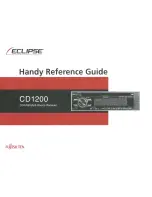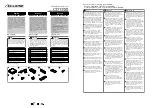
Frequently asked questions
15
Easylink feature does not work.
• Check if the TV and VCR support
Easylink.
• Check if you used full-wired SCART
cables.
Black and white image with S-VHS VCR.
• (Super Video Home System Video/
Cassette/Recorder)
• Check if the SCART connector of the
S-VHS VCR gives signal in CVBS.
(Composite Video Broadcast Signal).
See its user manual.
How can I find the IR sensor on the video
source?
• The blaster light needs to be
positioned precisely on the IR sensor
of the video source. Some equipments
have the letters IR at the front
indicating the location of the IR sensor.
In case there is no indication the
position can be found by moving the
blaster light slowly over the front of
the video source while a 2nd person
operates the remote control at the
location of TV2. At least make sure
that the remote control is out of range
of the video source. When the video
source starts to react the IR sensor
location is found. Mount the blaster
light on this location at the front of the
video source.
• Another possibility is to move the
remote control over the front of the
video source while operating it. Once
the video source starts to react the
location of the IR sensor is found. This
method is less accurate and does not
work for each remote control model.
• Also consult the documentation of
your video source to locate the IR
sensor.
How can I watch a different channel on
TV1 and TV2 simultaneously?
• Watching two different channels is
only possible if you use two tuners.
For example TV1 uses its internal
tuner and TV2 uses the tuner of the
VCR. For switching channels on TV2
you switch then between the channels
stored in the VCR. Note that this is
not possible when you have a digital
cable.
• Connect your antenna cable to both
your TV1 and your VCR.
• Search for the TV channels on your
VCR and store them in your VCR.
• Connect the transmitter (A) to the
output of the VCR.
• Connect the receiver (B) to the input
of TV2.
• To switch TV channels on TV2 switch
the channel on your VCR.





































